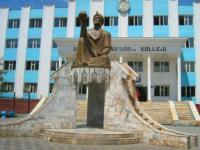You are here
Mamun Academy.

Places of interest of Urgench.
“We study, alas, for school, not for life”
Seneca.
Seven Wonders of Khorezm.
Central Asian region has made a significant contribution to the development of human civilization. In medieval times, there were many scientists and scientific schools in Central Asia, and Khorezm's Mamun Academy serves as a vivid example.
Political stability, economic and social development of Khorezm at the end of X - the beginning of XII century, as well as the fruitful relations of the peoples of the region have created favourable conditions for the formation of a scientific school in Gurganch (current Urgench).
In medieval sources there is no information on the exact date of the creation of the Academy of Mamun. However, there is credible evidence that Abu Rayhon Beruni and Abu Ali Ibn Sina (Avicenna) met in Gurganch for research in 1004.
Because of it we can assume that the Academy existed before due to the rulers of the dynasty of Khorezm. In 992, the new governor - Abu Ali Mamun came to power in Gurganch. During his reign, many scholars were invited for the development of scientific activities.
Despite the fact that Mamun Academy functioned until 1017, a lot of research in the field of astronomy, mathematics, medicine, chemistry, physics, geography, mineralogy, history, philosophy, literature, linguistics, law and other disciplines were still developing. In particular, in astronomy corrected the astronomical tables of the stars and the movement of the planets have been developed, as well as new astronomical instruments. Using these tools, Beruni predicted and explored the lunar eclipse in 1004.
Abu Mansur ibn Iraq, Beruni and Abu Khayr Khammor conducted studies in mathematics. Ibn Iraq, the teacher of Beruni, wrote about 30 academic books on mathematics and astronomy.
Beruni himself wrote articles on mathematics and astronomy in his 150 books. The theorem about the qualities of an isosceles triangle was proved by Abu Khayr Khammori and is widely known as "Theorem of Khammori" (ash-Shackle al-Khammori).
Biruni and Ibn Sina have contributed to the development of chemistry. Beruni proved a link between the relative weight of the substance and its chemical composition in the article on "Comparative weight."
Ibn Sina has done experiments on the chemical transformation of substances, these results have been described in the article "A Treatise on the Philosopher's Stone." As is known, this article appeared in Khorezm in 1005.
Scientists Abu Sahl al-Masihiy, Abu Khair Khammor, Ibn Sina and Beruni wrote scientific papers on medicine. In particular, Abu Khair Khammor was known as the Second Hippocrates for its innovative theoretical exercises in the areas of medicine, human anatomy, diet for older people, methods of medical experiment, food substances and epilepsy.
Abu Sahl al-Masihiy gained fame with practical exercises in medicine. Ibn Sino, despite its short five-year stay in Khorezm (1005-1010), wrote a very critical article on the treatment of wounds (Dafal-Mador).
Researches in geography were mainly related to the name of Beruni. Since the age of 16 he spent a lot of time by measuring the latitude of various places, for example, he calculated the latitude Kyat town in Khorezm.
In 994, he was able to measure the exact level of deviation of ecliptic plane of Bushkanz village (between the western shore of the Amu Darya and the city Kyat) in relation to the equator.
In 995 Beruni began research to create a picture of the Earth in the form of a globe. It was the first picture of the Earth in the form of a globe with relief. Beruni wrote scientific papers in various fields of geography such as natural geography, hydrology and mineralogy.
Mamun Academy in Khorezm is also renowned for his research in the social sciences. Philosophy was deeply studied on the correspondence of Beruni with Ibn Sina. Both scientists have expressed their views on philosophical ideas of Aristotle about the end of the world.
Biruni and Ibn Sina were supporters of the existence of other worlds and cultures. Studies of history have been widely deployed in Khorezm Academy of Mamun. To continue academic traditions Beruni wrote the book - "Famous people of Khorezm" or "History of Khorezm."
Unfortunately, the book has not been preserved, and the bulk of it was described in the book of Abu Fazl Bayhahy "History of Masudi", which was devoted to the sultan Masud Ghaznavi.
In addition, information has been found about the history of Beruni in other books such as "Monuments", "Knowledge" (Al-Tafhim) and "India". Judging by the books of al-Saolibi "Surprising information" ("Latoif al-Maorif" X-XI cc.), As-Samoni "Book of ancestors" ("Kitob al-ansob" XII centuries.) Yoqut al-Hamavi "Encyclopedia of Writers" ("Mujam al-udabo") and others, Mamun Academy enjoyed the fame of the centre of art and literature.
Many poets and writers, such as Ahmad bin Muhammad bin Sakhriy, Abdullo bin Hamid, Abu Sayyid bin Shabib, Abu Hassan bin Mamun, Abu Abdullo at-Tohir, Ibrokhim Rakkony worked at the Academy of Mamun.
Adviser to Khorezmshah al-Sahliy wrote poems and regularly organized the competition for literature in Khorezm Academy of Mamun. In this era the linguists of the Academy developed grammar of Arabic language and vocabulary, which has been an important tool for scientific communication.
Resolution of the 32nd session of the UNESCO General Conference in 2003 and the disposal of the Cabinet of Ministers dated November 9, 2004. "On the celebration of the 1,000th anniversary of Mamun Academy in Khorezm" gave impetus to the world research of famous medieval training academy and improved public understanding of science and cultural heritage of Uzbekistan.
Location: Khorezm region, Khiva district, Centre 1. Working hours: from 08.00 to 18.00. Tel: 375 51 43 www.mamun.uz
Authority:
http://welcomeuzbekistan.uz







